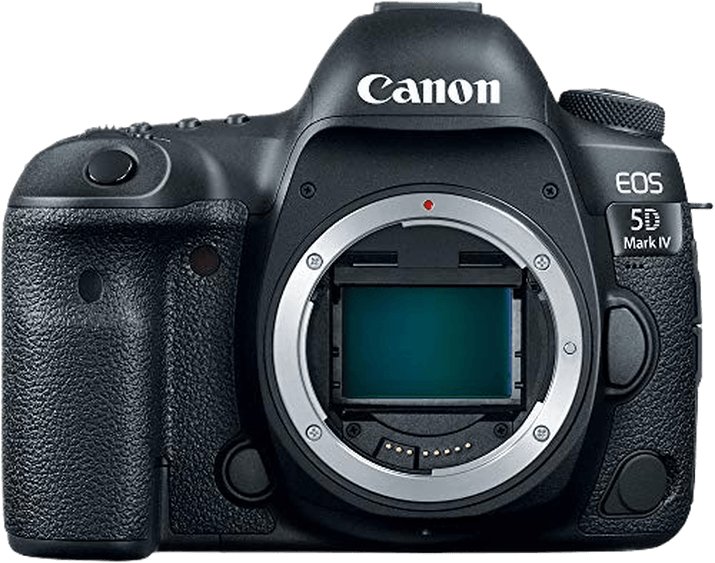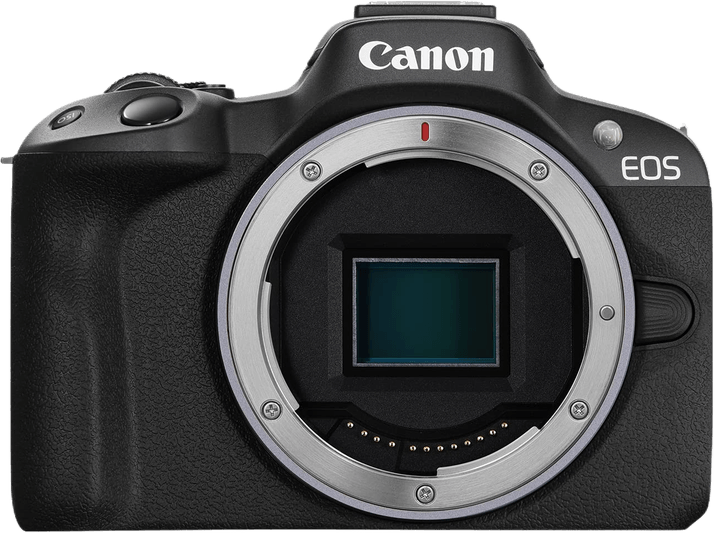Canon EOS 5D Mark IV vs EOS R50 Comparison
Canon EOS 5D Mark IV

Canon EOS R50

The Canon EOS 5D Mark IV outperforms the Canon EOS R50 with a score of 75/100 compared to 70/100. Both cameras share some common specs, such as being released by Canon and having similar announcement dates, with the 5D Mark IV in 2016 and the R50 in 2023.
The 5D Mark IV excels as a DSLR with a larger size of 151 x 116 x 76mm and a heavier weight of 890g, making it a more robust and professional choice. On the other hand, the EOS R50 shines as a mirrorless camera with its compact size of 116 x 86 x 69mm and lighter weight of 375g, making it more portable and affordable with a launch price of just $679 compared to the 5D Mark IV’s $3500.
While the 5D Mark IV offers superior performance, the R50 provides an excellent alternative for those seeking a lightweight and budget-friendly option. Each camera serves its purpose well, catering to different photography needs and preferences.
Canon EOS 5D Mark IV vs EOS R50 Overview and Optics
The Canon EOS 5D Mark IV outperforms the Canon EOS R50 in optics with a score of 76/100 compared to the R50’s 73/100. Both cameras share several features, including a CMOS sensor, no image stabilization, and a similar processor: the 5D Mark IV has a Digic 6+ processor, while the R50 has a Digic X processor.
The 5D Mark IV’s superiority in optics can be attributed to its higher megapixel count of 30.4, compared to the R50’s 24 megapixels. This difference allows for more detailed and higher resolution images. Additionally, the 5D Mark IV has a full-frame sensor, while the R50 has an APS-C sensor. A full-frame sensor generally provides better image quality and low-light performance. The 5D Mark IV also uses a Canon EF lens mount, which offers a wide range of compatible lenses.
On the other hand, the R50 has some advantages over the 5D Mark IV. It boasts a faster shooting speed of 12 frames per second, compared to the 5D Mark IV’s 7 frames per second. This makes the R50 more suitable for capturing fast-moving subjects. Furthermore, the R50 has a higher DXOMARK score for its sensor, scoring 94 points compared to the 5D Mark IV’s 91 points. The R50 also utilizes the Canon RF lens mount, which is designed for mirrorless cameras and offers a new range of high-quality lenses.
While both cameras have their strengths, the Canon EOS 5D Mark IV takes the lead in optics due to its higher megapixel count, full-frame sensor, and versatile lens mount. The Canon EOS R50, however, is a strong contender in speed and sensor quality, making it a suitable choice for specific photography needs.
Canon EOS 5D Mark IV vs EOS R50 Video Performance
The Canon EOS 5D Mark IV and the Canon EOS R50 both have a video score of 91/100, indicating that these cameras perform equally well in terms of video capabilities. They share common features such as a maximum video resolution of 4K and built-in time-lapse functionality. Additionally, both cameras can record videos at a maximum frame rate of 120fps, ensuring smooth and high-quality motion capture.
Despite having the same video score, the Canon EOS 5D Mark IV has a slight advantage in terms of maximum video dimensions, boasting 4096 x 2160 pixels compared to the Canon EOS R50’s 3840 x 2160 pixels. This difference allows the 5D Mark IV to capture slightly more detailed and higher resolution videos, providing a marginal edge over the R50.
On the other hand, the Canon EOS R50 does not have any distinct advantages over the 5D Mark IV in terms of video capabilities. Both cameras exhibit similar performance, and their shared features make them equally suitable for capturing high-quality videos.
In comparing the video capabilities of the Canon EOS 5D Mark IV and the Canon EOS R50, it is evident that both cameras perform exceptionally well. While the 5D Mark IV has a minor advantage in terms of maximum video dimensions, this difference is not significant enough to declare it as the clear winner. Ultimately, both cameras are excellent choices for those seeking a camera with impressive video capabilities.
Canon EOS 5D Mark IV vs EOS R50 Features and Benefits
The Canon EOS 5D Mark IV wins in the feature comparison with a score of 74/100, while the Canon EOS R50 scores 72/100. Despite the close scores, there are notable differences that set these two cameras apart.
Both cameras have a touchscreen with a screen resolution of 1,620,000 dots. They also have WIFI capabilities, making it easy to transfer photos and control the camera remotely. However, the 5D Mark IV has a larger screen size of 3.2 inches, compared to the R50’s 3 inches, providing a bigger display for framing and reviewing shots.
The 5D Mark IV is superior in terms of its GPS feature, which the R50 lacks. This allows photographers to geotag their images, making it convenient to track and organize photos by location. On the other hand, the R50 has a flip screen, which the 5D Mark IV does not. This feature is beneficial for capturing shots at difficult angles or when taking selfies.
Additionally, the R50 has Bluetooth connectivity, while the 5D Mark IV does not. This provides an extra option for transferring and sharing images and allows for seamless connection with compatible devices.
Despite the 5D Mark IV’s slightly higher score, the choice between these two cameras depends on the user’s priorities. The 5D Mark IV is more suitable for photographers who require GPS tagging and a larger screen size. In contrast, the R50 is a better option for those who value a flip screen and Bluetooth connectivity. Both cameras offer unique features, and users must consider their specific needs when making their decision.
Canon EOS 5D Mark IV vs EOS R50 Storage and Battery
The Canon EOS 5D Mark IV outperforms the Canon EOS R50 in storage and battery, scoring 71/100 compared to the R50’s 35/100. Both cameras accept SD/SDHC/SDXC memory cards, but the 5D Mark IV has two memory card slots and is compatible with UHS-I cards and Compact Flash, while the R50 has one slot and supports both UHS-I and II cards.
The 5D Mark IV’s battery life is significantly longer at 900 shots, using the LP-E6N battery type. On the other hand, the R50’s battery life is limited to 370 shots with the LP-E17 battery type. However, the R50 has the advantage of USB charging, which the 5D Mark IV lacks.
Given these specifications, the Canon EOS 5D Mark IV is the clear winner in storage and battery capacity, providing users with more versatility and longer shooting sessions. Despite the USB charging capability of the R50, its limited battery life and single memory card slot make it less competitive in this aspect.
Canon EOS 5D Mark IV vs EOS R50 – Our Verdict
Are you still undecided about which camera is right for you? Have a look at these popular comparisons that feature the Canon EOS 5D Mark IV or the Canon EOS R50:

